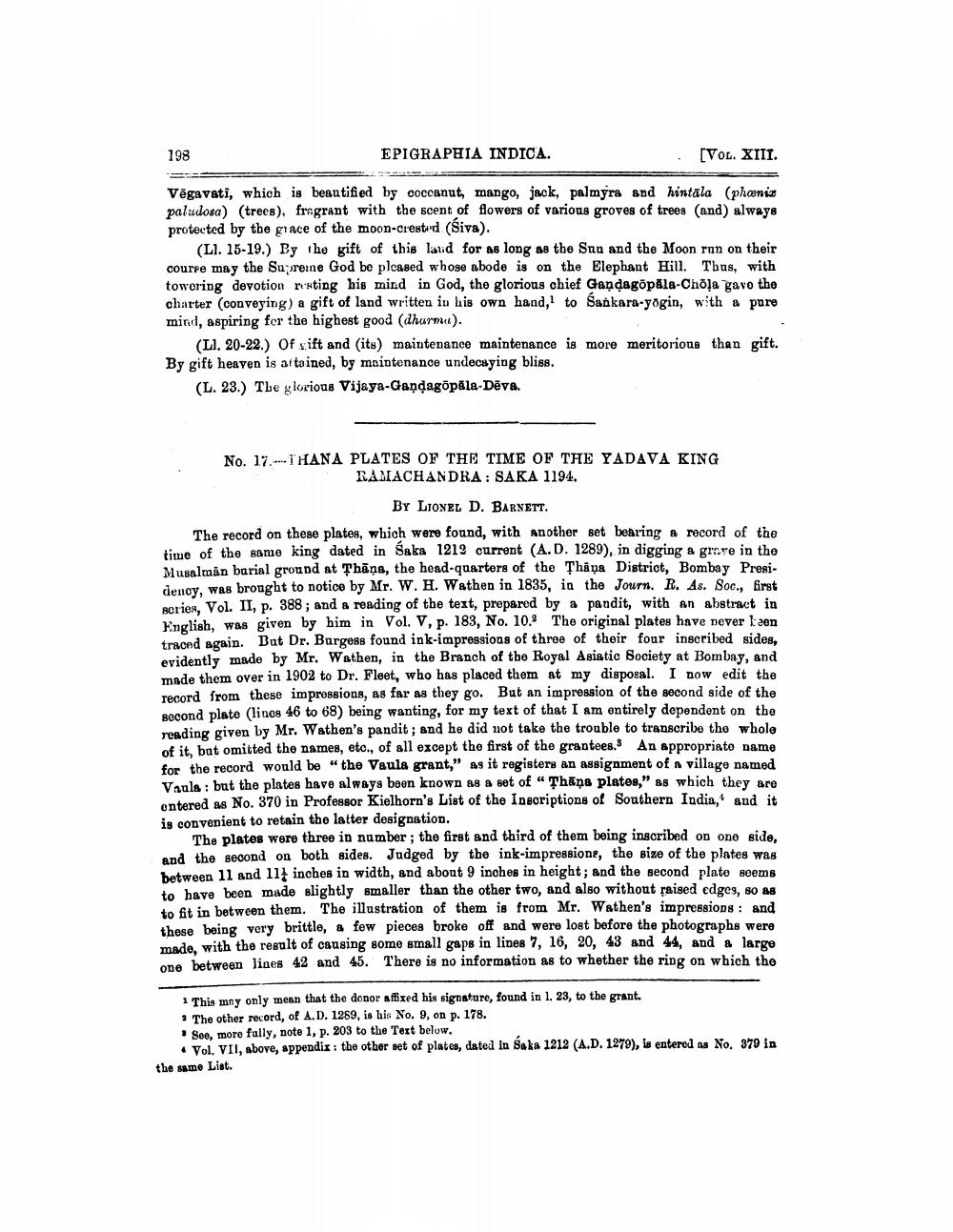________________
EPIGRAPHIA INDICA.
[VOL. XIII.
Vēgavati, which is beautified by coccanut, mango, jack, palmyra and hintala (phoenix paludosa) (trees), fragrant with the scent of flowers of various groves of trees (and) always protected by the grace of the moon-crested (Śiva).
198
(Ll. 15-19.) By the gift of this land for as long as the Sun and the Moon run on their course may the Supreme God be pleased whose abode is on the Elephant Hill. Thus, with towering devotion resting his mind in God, the glorious chief Gandagopala-Chōla gave the chatter (conveying) a gift of land written in his own hand, to Sankara-yogin, with a pure mind, aspiring for the highest good (dharma).
(Ll. 20-22.) Of gift and (its) maintenance maintenance is more meritorious than gift. By gift heaven is attained, by maintenance undecaying bliss.
(L. 23.) The glorious Vijaya-Gandagopala-Deva.
No. 17THANA PLATES OF THE TIME OF THE YADAVA KING RAMACHANDRA: SAKA 1194.
BY LIONEL D. BARNETT.
The record on these plates, which were found, with another set bearing a record of the time of the same king dated in Saka 1212 current (A.D. 1289), in digging a grave in the Musalman barial ground at Thana, the head-quarters of the Thana District, Bombay Presidency, was brought to notice by Mr. W. H. Wathen in 1835, in the Journ. R. As. Soc., first series, Vol. II, p. 388; and a reading of the text, prepared by a pandit, with an abstract in English, was given by him in Vol. V, p. 183, No. 10. The original plates have never leen traced again. But Dr. Burgess found ink-impressions of three of their four inscribed sides, evidently made by Mr. Wathen, in the Branch of the Royal Asiatic Society at Bombay, and made them over in 1902 to Dr. Fleet, who has placed them at my disposal. I now edit the record from these impressions, as far as they go. But an impression of the second side of the second plate (lines 46 to 68) being wanting, for my text of that I am entirely dependent on the reading given by Mr. Wathen's pandit; and he did not take the trouble to transcribe the whole of it, but omitted the names, etc., of all except the first of the grantees. An appropriate name for the record would be "the Vaula grant," as it registers an assignment of a village named Vaula: but the plates have always been known as a set of "Thana plates," as which they are entered as No. 370 in Professor Kielhorn's List of the Inscriptions of Southern India, and it is convenient to retain the latter designation.
The plates were three in number; the first and third of them being inscribed on one side, and the second on both sides. Judged by the ink-impressions, the size of the plates was between 11 and 11 inches in width, and about 9 inches in height; and the second plate seems to have been made slightly smaller than the other two, and also without raised edges, so as to fit in between them. The illustration of them is from Mr. Wathen's impressions: and these being very brittle, a few pieces broke off and were lost before the photographs were made, with the result of causing some small gaps in lines 7, 16, 20, 43 and 44, and a large one between lines 42 and 45. There is no information as to whether the ring on which the
1 This may only mean that the donor affixed his signature, found in 1. 23, to the grant.
2 The other record, of A.D. 1269, is his No. 9, on p. 178.
See, more fully, note 1, p. 203 to the Text below.
Vol. VII, above, appendix: the other set of plates, dated in Saka 1212 (A.D. 1279), is entered as No. 379 in
the same List.




